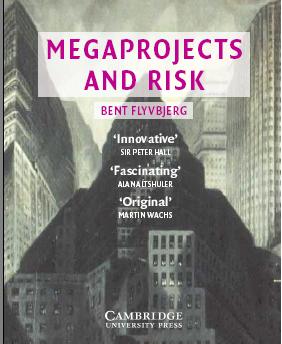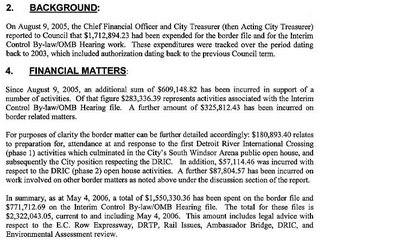Hot off the presses, the speech the President of the Bridge Co. to the Parliamentary Committee on Bill C-3
House of Commons Committee Hearings
Ambassador Bridge Testimony offered May, 2006
Dan Stamper, President
Thank you Mr. Chairman and thank you to all the members of the Committee for this much desired opportunity to speak today on the proposed legislation governing international border crossings between Canada and the United States. My name is Dan Stamper, and I am the President of the Ambassador Bridge, the number one border crossing in North America connecting Windsor, Ontario and Detroit, Michigan. With me today is Mr. Matthew Moroun, Vice-Chairman and Principal of Centra, Inc., our parent company and Mr. Skip McMahon, Executive Director of External Affairs, The Canadian Transit Company.
First, let me say, we are concerned with the intent and the spirit of Bill C-3 as it relates to our company. I would like to share our perspective of the effect of this Bill as it relates to our private sector enterprise and whether it would improve our accountability and add to our successful record of accomplishment of supporting trade and tourism for our region and the world. We have a story to tell, with responsibilities to our economic engines and with oversight from numerous agencies and our customers on both sides of the border. At the Ambassador Bridge, we know the world is watching – and we continue to earnestly perform our duties on a daily basis while preparing for the future.
Let me provide some background so you may clearly understand our concerns. In the early 1920’s a private entrepreneur developed a plan to finance, construct and operate a privately owned international bridge which became known as the Ambassador Bridge. This effort included the private investors taking the full risk of this investment and the responsibility to garner all property needed, necessary legislation in both countries along with local, state and provincial approvals. After accomplishing all of the above and constructing the bridge, the economies of both countries were affected by the Great Depression in the U.S. With no help from the government, the private investors reorganized and survived this horrific economic crisis.
From the mid 60’s the United States constructed interstate highways including I-75 to the Ambassador Bridge (no improvements to the Canadian roads to the bridge). In the late 80’s the United States and the Ambassador Bridge improved roadway connections on the U.S. side to the freeways (no improvements to the Canadian roads to the bridge). In the 90’s the United States and the Ambassador Bridge improved surface roads around the Ambassador Bridge and created additional access to and from the bridge (no improvements to the Canadian roads to the bridge). In the mid 90’s the city of Windsor developed a long-term transportation study (WALTS) at great expense to the city of Windsor and with participation and great expense to the Ambassador Bridge which identified how to finish 401 to the bridge (no improvements to the Canadian roads to the bridge). The report was shelved and never used. In the late 90’s the United States and the Ambassador Bridge started the Gateway Project, creating direct connections to and from the Ambassador Bridge to three (3) interstate highways, I-75, I-96 and I-94 while ensuring the addition of a twin span next to and west of the current Ambassador Bridge (no improvements to the Canadian roads to the bridge). In 2001 Ontario and Canada announced $300 million dollars to finish 401 to the current border crossing (In 2006, no improvements to the Canadian roads to the bridge). However, Canada has successfully built a $6 million dollar pedestrian crossing over Huron Church Road as their only improvement to the border crossing.
Our company has a reputation of speaking clearly on matters that involve our industry and I intend to do so today. Our effort today is to clarify and offer meaningful facts and direction for improving and strengthening the relationship between Canada and the Ambassador Bridge while acknowledging the differences between public and private border crossings, as well as to articulate our concerns about Bill-C3.
We believed the governance of the Ambassador Bridge by Canada was resolved and put to bed after more than a decade of litigation between the parties with an agreement reached in 1992. It is as if some people cannot forgive us for the way in which a 13 year litigation was settled in 1992. As the basis of this settlement, we agreed to invest millions of dollars in Canada on behalf of Canada Customs for new facilities solely at our expense. Since that date we have invested tens of millions of dollars more than what was required or agreed to under the terms of the settlement which created continuous and significant benefit to Canada.
Having gone above and beyond the terms of our 1992 agreement, we are troubled and question the true intent of Bill C-3. Comments made by a member of this government during a recent question and answer period only heightened our concern. The following comments were made by the Conservative MP for Essex:
“In my corridor, a private bridge operator is threatening the binational process for moving forward. This private interest is moving very quickly to twin the span there which really threatens to undermine a process that we are a partner in. It is important that we get this bill through in a very timely fashion without holding up too many add-ons because the clock is ticking with respect to this private interest moving forward. It is a project that, in my humble opinion, is not in the national interest, certainly not in the community interest.
It is important that all members in the House support this legislation and get it through quickly, so that we can avert this type of situation or at least have some oversight over what is happening. This is a necessary piece of legislation.”
It troubled me, quite frankly, when I read the Members’ speeches regarding Bill C-3 since they contained so much misinformation that was being discussed as if it were the truth. Whoever is perpetuating these myths is not doing a favor to the economies of the region nor to the economies of Canada, the United States, Michigan and Ontario. Those who believe that they are “helping” the region are hurting its citizens on both sides of the border as tourists and business investment are chased away.
I am really here to tell you about our positive actions for the border and how we want to work with the Canadian Government, but let me deal with a few of the more outrageous statements.
1) “When we look at the level of traffic and the impact of the backup of that traffic into communities such as Windsor, there obviously is a need for new bridges.”
The truth is that traffic at our crossing and at the Detroit/Windsor Tunnel is down about 30% from 1999 levels. The optimistic traffic numbers projected by DRIC have been revised downward several times already. With the Ontario Government “No Smoking ban” coming into effect on May 31, Windsor tourist business is projected to fall even more dramatically. In fact, our Bridge is only at 50% of its capacity now!
Yes, there were truck back-ups at our Bridge immediately after 9/11 as there were at every crossing. But why haven’t you been told that our Company, not the Canadian Government, fought and even sued the US Government successfully to build customs booths and to ensure they were fully staffed. When they opened, the truck back-ups disappeared. In fact, the Deputy Police Chief of Windsor wrote to me and complained that his biggest problem now is speeders on Huron Church Road (We will get back to this problem later.)
Here is what Windsor’s Deputy Police Chief wrote:
“In closing, where a year ago commercial truck vehicles on Huron Church Road and Wyandotte Street were often stagnant for extended periods of time requiring our resources to direct traffic to keep intersections clear, we now deploy our traffic personnel to this major artery for proactive traffic enforcement aimed at speeders. Whereas, a year ago, we couldn’t get commercial truck traffic to move anywhere we now have to work to ensure that all vehicle traffic abides by the speed limits on these same roadways. In addition, whereas a year ago, I was inundated with citizen calls almost daily regarding traffic flow issues in the Bridge area, I have not received any of these calls in the recallable past year.”
A second statement requires correction. In your Chambers it was stated that,
2) “In my corridor, a private bridge operator is threatening the binational process for moving forward. This private interest is moving very quickly to twin the span there which really threatens to undermine a process that we are a partner in… the clock is ticking with respect to this private interest moving forward.”
The facts are as follows:
A. After agreeing in 1992 to settle all outstanding litigation and investing tens of millions of dollars, we announced in 1993 that we were preparing to build additional lanes between Windsor, Ontario and Detroit, Michigan consistent with that agreement.
B. The Canadian Transit Company publicly began its effort to enhance its facilities in 1993 and has continued to acquire the necessary property and engage consultants and engineers to prepare all necessary documents and approvals to allow the construction of additional lanes over the water.
C. It is DRIC that began in 2001 and has been rushed in an effort to catch up with and replace the Ambassador Bridge’s commitment for additional lanes.
D. The same bureaucrats in charge of the DRIC process are the people responsible for approvals of the Ambassador Bridge project. This creates a group of bureaucrats as a competitor of the Ambassador Bridge, at the government owned Sarnia / Port Huron bridge, and creates a direct conflict since they are judge, jury and executioner when it comes to the Ambassador Bridge projects.
E. Thirty percent (30%) of all international commercial crossings are destined for or emanate from industrial businesses in Windsor. This number is so large that if a separate crossing were built just for Windsor shippers it would be the fourth largest crossing at the border. The reality is Windsor is an industrial town and any new truck tunnel or dedicated road will not change things; this is a pipe dream for the naive.
It is NOT my desire to be offensive but the truth does need to be told. As mentioned earlier with regard to Huron Church Road, the fact is, there are problems at the border. The main impediment at the border is the lack of any adequate surface roads and a thoroughfare from the Ambassador Bridge to Highway 401 on the Canadian side of the border for use by not only international traffic but Windsorites as well. The fact is that Michigan has invested $184 million federal and state tax dollars for the Ambassador Bridge Gateway infrastructure. Michigan has streamlined and maximized border investment with the Gateway and the Ambassador Bridge has invested nearly $500 million private dollars preparing for additional lanes between Windsor and Detroit. Windsor roads from the border to the 401 remain deficient and will impede trade in this corridor. Despite all of the public and private dollars invested on the U.S. side of the Bridge…despite the $300 million Canada’s federal and provincial governments announced in 2001 allocated to improve access to current border facilities…Canada has failed to solve their well known problem: a road from 401 to the border. Also, there is a serious under developed road system surrounding the border crossing. We will stand in line first to support improvements to the Canadian connections to the Ambassador Bridge and urge you to focus efforts in this direction. In our view, public monies that would be devoted to a new crossing, which will disrupt communities not now impacted by a bridge, would be better spent on improvements to the existing corridor.
Now, specifically regarding Bill C-3 and the “health, safety and security” aspects of the Bill, I am certain that mutual agreement can be worked out on the technical terms as has been achieved in the past. We have little difficulty with security matters either because immediately after 9/11 we engaged, managed and are paying for 24 hour a day armed security at the Ambassador Bridge, unlike other border crossings. Most of the latest security technology innovations are put into service first at the Ambassador Bridge.
We are aware that the Bridge and Tunnel Operators Association has given testimony regarding the sections of Bill C-3 dealing with toll collection and financing. We respectfully request the right to submit additional information regarding more appropriate language dealing with the Ambassador Bridge as a private owner and long-term operator of the most efficient international border crossing in North America and consistent with all earlier legislation both in Canada and the U.S. and agreements between the parties.
To the extent that the sponsors of Bill C-3 are trying to emulate the Presidential Permit process in the United States, they have not done so in Bill C-3. The Presidential Permit process is designed to focus on the single issue of whether new border infrastructure is in the public interest. Thus, the U.S. agency which decides whether to issue such permits, the Department of State, focuses only on that public interest issue and does not involve itself in approval of changes of ownership of bridges or operation of bridges. Ownership and operation are matters left to the bridge owner, both by the U.S. and by Canada. This is wise policy since there is no reason to believe that the private sector will not do a good job in self-regulation, as it has for decades without any problem.
By contrast, Bill C-3 would involve the Canadian Government in such matters. However, Bill C-3 is much too invasive in injecting Government into the regulation of bridges. For example, the Bill unnecessarily puts the Governor-in-Council into a micro-management position by authorizing it to adopt regulations on the operation and use of each bridge.
Simply stated, there is no problem with the status quo that would warrant this proposed new level of government involvement. Bill C-3 is a solution in search of a problem.
Further, in the case of the plans to add another span to the Ambassador Bridge, the State Department has determined that no Presidential Permit is needed since the Ambassador Bridge has previously been approved by statute. So too in Canada, existing bridges should be grandfathered as against any requirements relative to obtaining approval for new construction or alteration. Any other approach will cause private investors to think long and hard before making significant infrastructure investments.
On the other hand, to the extent that Canada wishes to take reasonable steps to insure that persons with criminal backgrounds or persons who pose security risks, do not control, or come into control of, new or existing international crossings, we have no objection to that type of limited and reasonable regulation to protect the public interest. At the same time, any new measure should make clear that foreign ownership in and of itself is not unlawful or impermissible, or grounds for disapproval. Government regulation in this area that goes beyond reasonable security considerations might stifle private investment and involve the government in private sector affairs best left unregulated.
Further, Bill C-3 carries with it the risk of inappropriate extraterritorial impact. At a minimum, the bill should be amended to provide that the Government be advised of a change of control in ownership, not that it be given a right to approve or disapprove control, other than for security concerns and then only after consultation with the U.S. This will ensure against unilateral action on a matter as fundamentally bi-national as a bridge across the border.
The scope of the regulatory making authority must be focused exclusively on the purpose of Bill-C3 (ie. Safety and security).
Further, I note that there has been a trend in recent months in our nations and elsewhere to enhancing the growth and benefits of privately owned infrastructure projects. The Ambassador Bridge and several new or planned privately sponsored toll roads offer examples. The growth of private investment in infrastructure should be promoted by the Canadian Government as a means of achieving the benefits of private funding and efficient operation, saving taxpayer dollars for use on other projects. As noted above, public funds could be well spent in Canada in improving the approaches to the Ambassador Bridge.
We have a long term relationship with the Government of Canada and the Government of The United States built on 78 years of history and respect. Now the Government of Canada unilaterally attempts to wipe away what we have achieved with the stroke of a pen. Moreover, the Bill as drafted seems to allow the Government to act retroactively as well.
As you are aware, there are numerous pieces of legislation governing the Ambassador Bridge not only in Canada but the U.S. as well. This legislation in both countries has been created and together they govern the Ambassador Bridge as an international border crossing. Any unilateral change may disrupt the meaning and application of these international agreements. If changes are needed, we are ready to work closely with the government to develop meaningful legislation that continues to protect the public and creates an environment that not only allows for but motivates the border crossing owner / operators, whether public or private, to invest in and manage efficient border crossings for the good of Canada and The United States. We are NOT a new company starting out but a legitimate border operator who has done its best for the good of this Country and its American neighbor for over 75 years.
We are not looking for another drawn out and disruptive legal mêlée. Lawsuits are not productive and are expensive while taking up time and effort that could be used more effectively in accomplishing something positive. We want to work with the Governments of Canada, Ontario and Windsor along with those in the United States, Michigan and Detroit to provide the most effective border crossing experience for business and consumers in North America. We are already the best operator according to a US Government Report and intend to remain #1. We also are fully prepared for the future and believe that meaningful and thoughtful legislation will ensure that all border crossings can fulfill their mandates on behalf of Canada.
We would like to invite any and all members of Parliament to visit the Ambassador Bridge for a tour, either as a group or as individuals. We would be pleased to host such a tour of the entire facility so they are able to see first hand that it is a total international piece of infrastructure, not just two halves being operated separately. A tour would help crystallize and clarify your views with a greater insight to the perception and actual restrictions we face.
If I may leave you with one message, the Ambassador Bridge Company wants to work co-operatively with your Government and those others involved for the good of both citizens and the economy. Irritants such as those in Bill C-3 can be dealt with if the parties are willing to do so. We stand ready to meet with representatives from the Canadian government for the betterment of the border and Canada similar to what we accomplished in 1992.
We invite questions from the Members of the committee and will try our best to answer.












